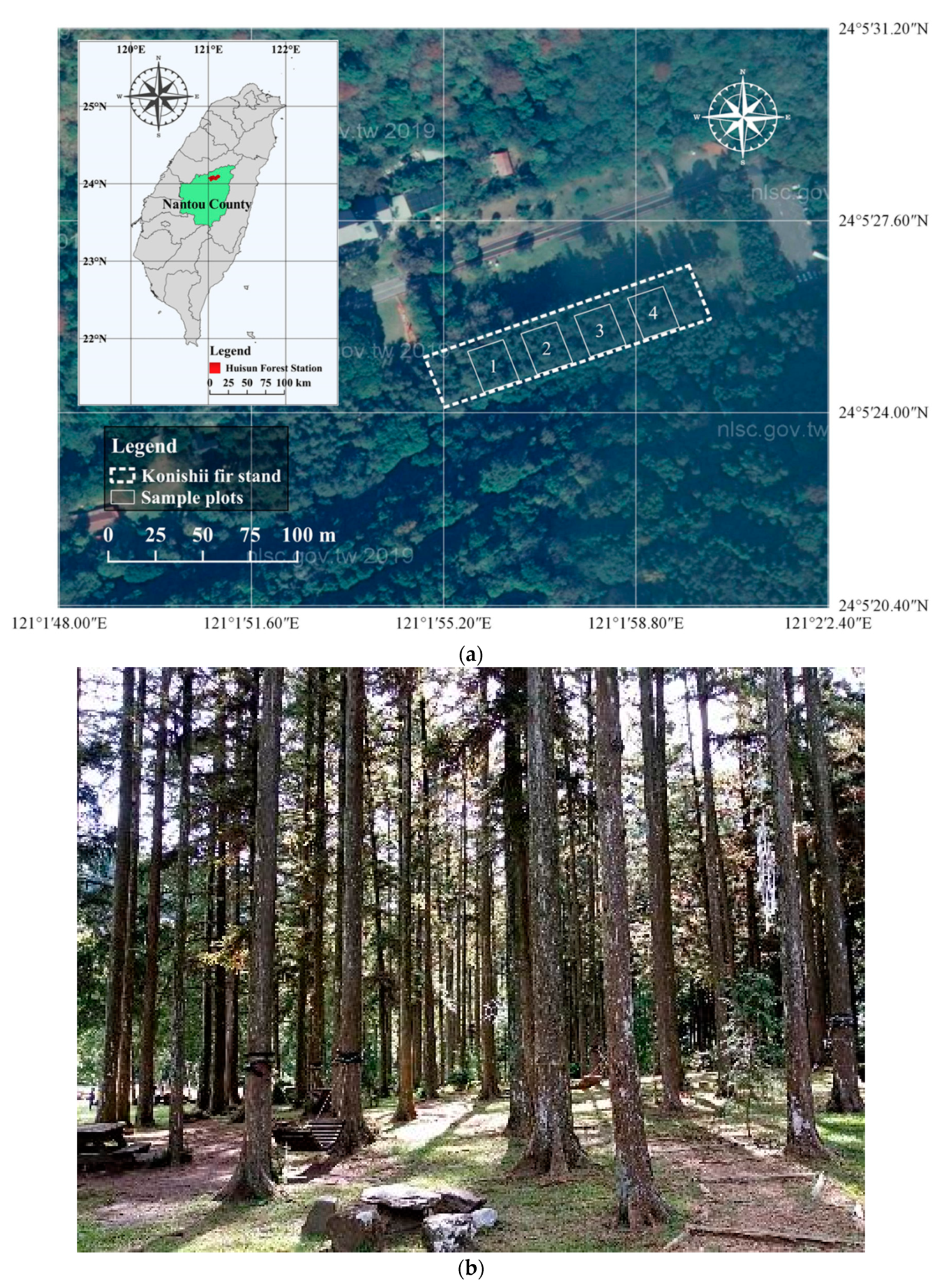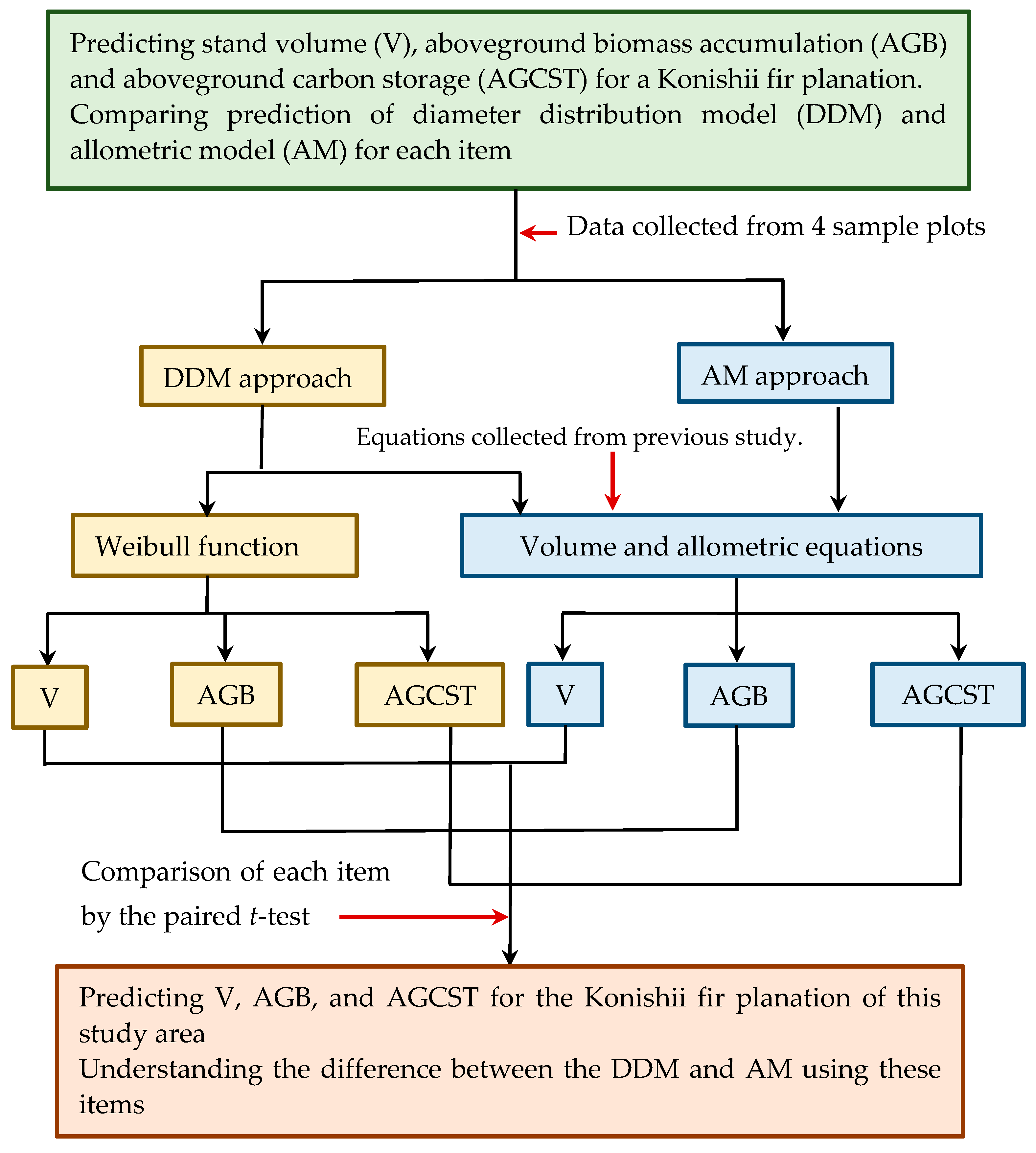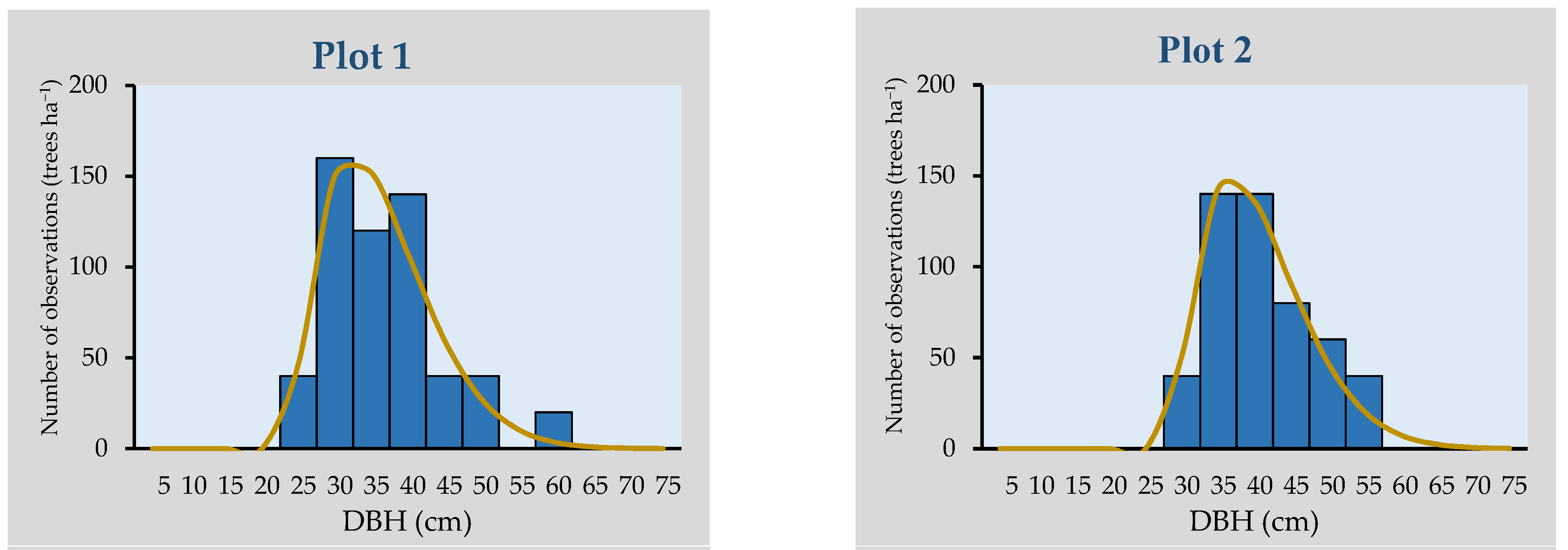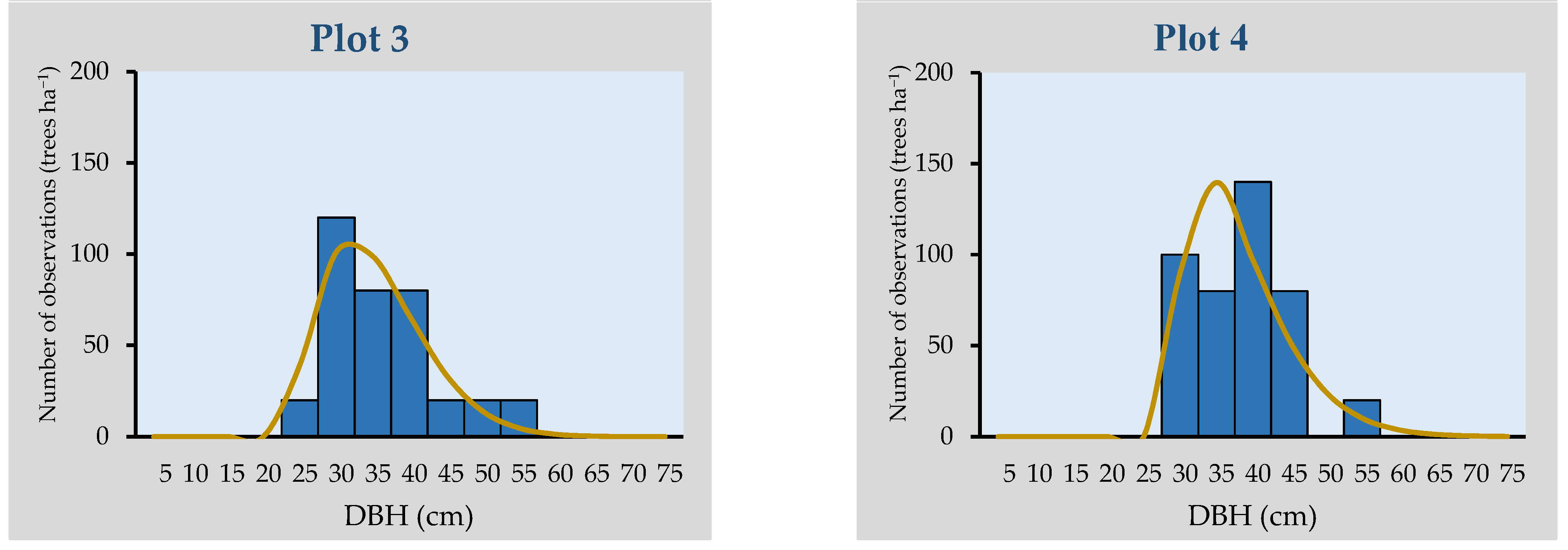Application of Models to Predict Stand Volume, Aboveground Biomass Accumulation, and Carbon Storage Capacity for a Konishii Fir (Cunninghamia konishii Hayata) Plantation in Central Taiwan
Abstract
:1. Introduction
2. Materials and Methods
2.1. Study Areas
2.2. Data Collection
2.3. Method
2.3.1. Research Framework
2.3.2. Tree Height Equation
2.3.3. Diameter Distribution Model for Predicting Stand Volume, Aboveground Biomass Accumulation, and Aboveground Carbon Storage
2.3.4. Allometric Model for Predicting Stand Volume, Aboveground Biomass Accumulation, and Aboveground Carbon Storage
2.3.5. Comparing Stand Volume, Aboveground Biomass Accumulation, and Aboveground Carbon Storage between the Two Models
3. Results
3.1. Stand Characteristics
3.2. Tree Height Equation
3.3. Quantifying Stand Diameter Distribution by Weibull Function
3.4. Diameter Distribution Model
3.5. Allometric Model
3.6. Comparison of the Two Models
4. Discussion
5. Conclusions
6. Patents
Author Contributions
Funding
Acknowledgments
Conflicts of Interest
References
- FAO. Global Forest Resources Assessment: Main Report-Rome. 2020. Available online: https://doi.org/10.4060/ca9825en (accessed on 14 August 2021).
- Bauhus, J.; van der Meer, P.; Kanninen, M. Improved ecosystem services from plantations of the future. In Ecosystem Goods and Services from Plantation Forests, 1st ed.; Routledge: London, UK, 2010; pp. 205–227. [Google Scholar]
- Li, D.; Niu, S.; Luo, Y. Global patterns of the dynamics of soil carbon and nitrogen stocks following afforestation: A meta-analysis. New Phytol. 2012, 195, 172–181. [Google Scholar] [CrossRef] [PubMed]
- Allan, C.; Kerr, S. Examining patterns in and drivers of rural land use values. In Proceedings of the New Zealand Agricultural and Resource Economics Society Conference, Lincoln University, Canterbury, New Zealand, 28–30 August 2013. [Google Scholar] [CrossRef]
- International Panel on Climate Change (IPCC). Climate Change and Land: Summary for Policy Maker. 2019. Available online: https://www.ipcc.ch/srccl/ (accessed on 13 August 2021).
- Jarvis, P.G.; Kramer, P.J.; Kozlowski, T.T. Physiology of Woody Plants. J. Appl. Ecol. 1983, 20, 352. [Google Scholar] [CrossRef]
- Lamlom, S.; Savidge, R. A reassessment of carbon content in wood: Variation within and between 41 North American species. Biomass Bioenergy 2003, 25, 381–388. [Google Scholar] [CrossRef]
- Chung, J.-D.; Nigh, G.; Chien, C.-T.; Ying, C.C. Genetic Variation and Tree Improvement of Konishii fir (Cunninghamia lanceolata (Lamb.) Hook. var. konishii) in Taiwan. Silvae Genet. 2011, 60, 196–205. [Google Scholar] [CrossRef] [Green Version]
- Yen, T.-M.; Wang, C.-T. Assessing carbon storage and carbon sequestration for natural forests, man-made forests, and bamboo forests in Taiwan. Int. J. Sustain. Dev. World Ecol. 2013, 20, 455–460. [Google Scholar] [CrossRef]
- Yen, T.-M.; Huang, K.-L.; Li, L.-E.; Wang, C.-H. Assessing carbon sequestration in plantation forests of important conifers based on the system of permanent sample plots across Taiwan. J. Sustain. For. 2019, 39, 392–406. [Google Scholar] [CrossRef]
- Lin, K.C.; Wang, C.P.; Huang, C.M.; Horng, F.W.; Chiu, C.M. Estimates of biomass and carbon storage in two Taiwania plantations of Liukuei Experimental Forest. Taiwan J. For. Sci. 2003, 18, 85–94. Available online: https://eurekamag.com/research/003/754/003754817.php (accessed on 3 July 2021).
- Shih, C.-Y.; Yen, T.-M.; Wang, Y.-N. Comparison of various growth functions for predicting long-term stand development associated with different initial spacing in 64-year-old Japanese cedar (Cryptomeria japonica (L.f.) D. Don) plantations. Ann. For. Res. 2021, 64, 87–97. [Google Scholar] [CrossRef]
- Taiwan Forestry Bureau (TFB). Forest Resource Management. 2021. Available online: https://www.forest.gov.tw/EN/0002664 (accessed on 24 May 2021).
- Liu, Y.-H.; Yen, T.-M. Assessing aboveground carbon storage capacity in bamboo plantations with various species related to its affecting factors across Taiwan. For. Ecol. Manag. 2020, 481, 118745. [Google Scholar] [CrossRef]
- Nath, A.J.; Das, G.; Das, A.K. Above ground standing biomass and carbon storage in village bamboos in North East India. Biomass Bioenergy 2009, 33, 1188–1196. [Google Scholar] [CrossRef]
- Yen, T.; Ai, L.; Li, C.; Lee, J.; Huang, K. Aboveground carbon contents and storage of three major Taiwanese conifer species. Taiwan J. For. Sci. 2009, 24, 91–102. [Google Scholar]
- Li, L.E.; Lin, Y.J.; Yen, T.M. Using allometric models to predict the aboveground biomass of thorny bamboo (Bambusa stenostachya) and estimate its carbon storage. Taiwan J. For. Sci. 2016, 31, 37–47. [Google Scholar]
- Yen, T.-M.; Ji, Y.-J.; Lee, J.-S. Estimating biomass production and carbon storage for a fast-growing makino bamboo (Phyllostachys makinoi) plant based on the diameter distribution model. For. Ecol. Manag. 2010, 260, 339–344. [Google Scholar] [CrossRef]
- Strub, M.R.; Burkhart, H.E. A class-interval-free method for obtaining expected yields from diameter distributions. For. Sci. 1975, 21, 67–69. [Google Scholar] [CrossRef]
- Hyink, D.M.; Moser, J.W. A generalized framework for projecting forest yield and stand structure using diameter distributions. For. Sci. 1983, 29, 85–95. [Google Scholar] [CrossRef]
- Liu, Y.H.; Lin, Z.R.; Yen, T.M. Comparison of biomass prediction by various approaches for a makino bamboo (Phyllostachys makinoi Hayata) plantation. Q. J. Chin. For. 2019, 41, 203–215. [Google Scholar]
- Bailey, R.; Dell, T. Quantifying Diameter Distributions with the Weibull function. For. Sci. 1973, 19, 97–104. [Google Scholar] [CrossRef]
- Cao, Q.V. Use of the Weibull function to predict future diameter distributions from current plot data. In Proceedings of the 16th Biennal Silvicultural Research Conference, US Department of Agriculture Forest Service, Southern Research Station, Asheville, NC, USA, 4 May 2012; Volume 156, pp. 53–58. [Google Scholar]
- Russell, M.B.; Burkhart, H.E.; Amateis, R.L.; Prisley, S.P. Regional Locale and Its Influence on the Prediction of Loblolly Pine Diameter Distributions. South. J. Appl. For. 2012, 36, 198–203. [Google Scholar] [CrossRef] [Green Version]
- Huang, K.L.; Wang, C.H.; Yen, T.M.; Li, L.E. Evaluation of the Applicability of the Weibull Probability Density Function with Different Approaches for Diameter Distributions of Plantations of Four Conifer Species. Taiwan J. For. Sci. 2015, 30, 1–13. [Google Scholar]
- Diamantopoulou, M.J.; Özçelik, R.; Crecente-Campo, F.; Eler, Ü. Estimation of Weibull function parameters for modelling tree diameter distribution using least squares and artificial neural networks methods. Biosyst. Eng. 2015, 133, 33–45. [Google Scholar] [CrossRef]
- Nga, N.T.T.; Dung, N.A.; Chung, N.T.; Thai, T.H.; Hung, N.D. The distribution and some ecological characteristics, and essential oil of Cunninghamia konishii Hayata in Pu Hoat nature reserve, Nghe an province, Vietnam. Eng. Appl. Sci. Res. 2016, 43, 121–124. [Google Scholar]
- Kuo, P.C. The Precious 5 Conifers of Taiwan; Chinese Forestry Association: Taipei, Taiwan, 1995. [Google Scholar]
- Yang, J.C.; Lee, C.H.; Chiu, C.M. Genetic variation of wood density in Lunata fir tested in central Taiwan. Wood Fiber Sci. 2001, 33, 486–491. [Google Scholar]
- Zhou, L.; Shalom, A.-D.D.; Wu, P.; Li, S.; Jia, Y.; Ma, X. Litterfall production and nutrient return in different-aged Chinese fir (Cunninghamia lanceolata) plantations in South China. J. For. Res. 2015, 26, 79–89. [Google Scholar] [CrossRef]
- Su, Y.-C.; Hsu, K.-P.; Ho, C.-L. Composition, in vitro Cytotoxicity, Anti-mildew and Anti-wood-decay Fungal Activities of the Bark Essential Oil of Cunninghamia lanceolata var. konishii from Taiwan. Nat. Prod. Commun. 2018, 13. [Google Scholar] [CrossRef] [Green Version]
- Liu, T. Study on the photogepgraphy of the conifers and Taxads of Taiwan. Bull. Taiwan For. Res. Inst. 1966, 122, 1–33. [Google Scholar]
- NCHU. Experimental Stations and Forest Plantations. 2021. Available online: https://www.nchu.edu.tw/default/mid/685 (accessed on 27 May 2021).
- Lin, W.P. A Multi objective Planning System for Forest Resource Management in Taiwan: A Case Study on Hui-Sun Forest Station. Ph.D. Thesis, University of Hawaii at Manoa, Honolulu, HI, USA, 2003. [Google Scholar]
- Experimental Forest Management Office (EFMO). A Brief Introduction to The Experimental Forest, College of Agriculture and Natural Resource of National Chung Hsing University; Experimental Forest Management Office (EFMO), College of Agriculture and Natural Resource of National Chung Hsing University: Taichung, Taiwan, 2006; pp. 1–42. [Google Scholar]
- Chiu, C.M.; Suen, M.Y.; Tang, S.C.; Yu, C.R. Establishing Damaged Luanta-Fir (Cunninghamia Konishii) Plantations with Multistoried Forests- Growth of Six Kinds of Underplanting Hardwood Seedlings. Q. J. Chin. For. 2010, 43, 39–54. [Google Scholar] [CrossRef]
- Liu, Y.C. The clone bank and controlled pollination of Luanta-fir (Study on the sprouting vigor of the scion stools and the technique of the controlled pollination for inbreeding). Q. J. Chin. For. 1971, 5, 1–17. [Google Scholar]
- National Land Surveying and Mapping Center (NLSC). Taiwan MAP Service. Available online: http://maps.nlsc.gov.tw/ (accessed on 9 August 2021).
- Bailey, R.L. Weibull model for Pinus radiata diameter distribution. Stat. For. Res. 1974, 4, 51–59. [Google Scholar]
- Zanakis, S.H. A simulation study of some simple estimators for the three-parameter weibull distribution. J. Stat. Comput. Simul. 1979, 9, 101–116. [Google Scholar] [CrossRef]
- Law, A.M. Simulation Modeling and Analysis, 5th ed.; McGraw-Hill Education: New York, NY, USA, 2014. [Google Scholar]
- Yen, T.M.; Lee, J.S.; Huang, K.L.; Liu, C.C. Tree growth and biomass of a mature China-fir (Cunninghamia lanceolata) plantation. Q. J. Chin. For. 2004, 37, 157–168. [Google Scholar] [CrossRef] [Green Version]
- Yen, T.-M.; Lee, J.-S. Comparing aboveground carbon sequestration between moso bamboo (Phyllostachys heterocycla) and China fir (Cunninghamia lanceolata) forests based on the allometric model. For. Ecol. Manag. 2011, 261, 995–1002. [Google Scholar] [CrossRef]
- Cao, Q.V. Predictions of individual-tree and whole-stand attributes for loblolly pine plantations. For. Ecol. Manag. 2006, 236, 342–347. [Google Scholar] [CrossRef]
- Ajayi, S. Diameter Distribution for Gmelina Arborea (ROXB) Plantations in Ukpon River Forest Reserve, Cross River State, Nigeria. AFRREV STECH Int. J. Sci. Technol. 2013, 2, 64–82. [Google Scholar]
- Abino, A.C.; Kim, S.Y.; Lumbres, R.I.C.; Na Jang, M.; Youn, H.J.; Park, K.H.; Lee, Y.J. Performance of Weibull function as a diameter distribution model for Pinus thunbergii stands in the eastern coast of South Korea. J. Mt. Sci. 2016, 13, 822–830. [Google Scholar] [CrossRef]
- Food and Agriculture Organization (FAO). Global Forest Resource Assessment 2005. 2006. Available online: http://www.fao.org/forest-resources-assessment/past-assessments/fra-2005/en/ (accessed on 13 August 2021).
- West, P.W. Growing Plantation Forests, 1st ed.; Springer: Berlin/Heidelberg, Germany, 2006. [Google Scholar]
- Pan, Y.; Luo, T.; Birdsey, R.; Hom, J.; Melillo, J. New estimates of carbon storage and sequestration in China’s forests: Effects of age–class and method on inventory-based carbon estimation. Clim. Chang. 2004, 67, 211–236. [Google Scholar] [CrossRef]
- Yao, Y.; Piao, S.; Wang, T. Future biomass carbon sequestration capacity of Chinese forests. Sci. Bull. 2018, 63, 1108–1117. [Google Scholar] [CrossRef] [Green Version]
- Wang, Q.; Wang, S.; Zhang, J. Assessing the effects of vegetation types on carbon storage fifteen years after reforestation on a Chinese fir site. For. Ecol. Manag. 2009, 258, 1437–1441. [Google Scholar] [CrossRef]
- Chen, G.-S.; Yang, Z.-J.; Gao, R.; Xie, J.-S.; Guo, J.-F.; Huang, Z.-Q.; Yang, Y.-S. Carbon storage in a chronosequence of Chinese fir plantations in southern China. For. Ecol. Manag. 2012, 300, 68–76. [Google Scholar] [CrossRef]
- Zhao, M.; Xiang, W.; Peng, C.; Tian, D. Simulating age-related changes in carbon storage and allocation in a Chinese fir plantation growing in southern China using the 3-PG model. For. Ecol. Manag. 2009, 257, 1520–1531. [Google Scholar] [CrossRef]
- Saeed, S.; YuJun, S.; Beckline, M.; Chen, L.; Zhang, B.; Ahmad, A.; Mannan, A.; Khan, A.; Iqbal, A.; Saeed, S.; et al. Forest edge effect on biomass carbon along altitudinal gradients in Chinese Fir (Cunninghamia lanceolata): A study from Southeastern China. Carbon Manag. 2019, 10, 11–22. [Google Scholar] [CrossRef]
- Wei, H.D.; Liu, A.Q.; Ma, X.Q.; Lin, K.M. Effects of successive planting on carbon storage of Chinese fir forest. Chin. J. Ecol. Agric. 2006, 14, 36–39. Available online: http://ecoagri.ac.cn/article/id/2006310 (accessed on 13 August 2021).
- Wang, K.; Hu, D.; Deng, J.; Shangguan, Z.; Deng, L. Biomass carbon storages and carbon sequestration potentials of the Grain for Green Program-Covered Forests in China. Ecol. Evol. 2018, 8, 7451–7461. [Google Scholar] [CrossRef]
- Jiang, P.; Meng, C.; Zhou, G.; Xu, Q. Comparative Study of Carbon Storage in Different Forest Stands in Subtropical China. Bot. Rev. 2011, 77, 242–251. [Google Scholar] [CrossRef]
- Zhang, H.; Zhou, G.; Wang, Y.; Bai, S.; Sun, Z.; Berninger, F.; Bai, Y.; Penttinen, P. Thinning and species mixing in Chinese fir monocultures improve carbon sequestration in subtropical China. Eur. J. For. Res. 2019, 138, 433–443. [Google Scholar] [CrossRef]
- Cheng, X.; Yu, M.; Wang, G.G. Effects of Thinning on Soil Organic Carbon Fractions and Soil Properties in Cunninghamia lanceolata Stands in Eastern China. Forests 2017, 8, 198. [Google Scholar] [CrossRef] [Green Version]
- Tang, X.; Fehrmann, L.; Guan, F.; Forrester, D.I.; Guisasola, R.; Pérez-Cruzado, C.; Vor, T.; Lu, Y.; Álvarez-González, J.G.; Kleinn, C. A generalized algebraic difference approach allows an improved estimation of aboveground biomass dynamics of Cunninghamia lanceolata and Castanopsis sclerophylla forests. Ann. For. Sci. 2017, 74, 12. [Google Scholar] [CrossRef] [Green Version]
- Xie, X.; Cui, J.; Shi, W.; Liu, X.; Tao, X.; Wang, Q.; Xu, X. Biomass partition and carbon storage of Cunninghamia lanceolata chronosequence plantations in Dabie Mountains in East China. Dendrobiology 2016, 76, 165–174. [Google Scholar] [CrossRef]
- Tang, X.; Lu, Y.; Fehrmann, L.; Forrester, D.I.; Guisasola-Rodríguez, R.; Pérez-Cruzado, C.; Kleinn, C. Estimation of stand-level aboveground biomass dynamics using tree ring analysis in a Chinese fir plantation in Shitai County, Anhui Province, China. New For. 2015, 47, 319–332. [Google Scholar] [CrossRef]
- Kondo, T.; Yamada, H.; Otsuka, J.; Isoda, K.; Yamaguchi, S.; Ubukata, M. Growth of Cunninghamia lanceolata in Japan. For. Genet. Tree Breed. 2020, 9, 1–11. [Google Scholar] [CrossRef]




| Items | Equations | Species and Site | References |
|---|---|---|---|
| Volume | V = (0.000033DBH1.9092 × H1.1170)−0.0122 | China fir in central Taiwan | Yen et al. [42] |
| Aboveground biomass | AGB = 0.1502DBH2.2273 | China fir in central Taiwan | Yen et al. [42] |
| Aboveground carbon storage | AGCST = 0.0681DBH2.2521 | China fir in central Taiwan | Yen et al. [16] |
| Items | Number of Plots | Minimum | Maximum | Mean | Standard Deviation |
|---|---|---|---|---|---|
| Number of trees (trees ha−1) | 4 | 360 | 560 | 460 | 88 |
| DBH (cm) | 4 | 33.85 | 38.29 | 35.49 | 1.99 |
| Tree height (m) | 4 | 25.24 | 26.72 | 25.84 | 0.69 |
| Basal area (m2 ha−1) | 4 | 34.18 | 59.41 | 47.77 | 11.39 |
| Parameters | K–S Test | |||||
|---|---|---|---|---|---|---|
| a | b | c | 1 | 2 | Result | |
| 1 | 21.81 | 13.39 | 1.70 | 0.514 | 0.846 | pass |
| 2 | 26.55 | 12.84 | 1.69 | 0.697 | 0.845 | pass |
| 3 | 21.00 | 13.32 | 1.79 | 0.743 | 0.838 | pass |
| 4 | 26.10 | 10.49 | 1.44 | 0.824 | 0.843 | pass |
| Mean | 23.87 ± 2.87 | 12.51 ± 1.37 | 1.66 ± 0.15 | 0.695 ± 0.131 | 0.843 ± 0.004 | |
| Plot | Diameter Class (cm) | Number of Trees (trees ha−1) | Tree Height 1 (m) | V (m3 ha−1) | AGB (Mg ha−1) | AGCST (Mg ha−1) |
|---|---|---|---|---|---|---|
| 1 | 20 ≤ x< 25 | 46.57 | 22.70 | 18.62 | 7.19 | 3.52 |
| 25 ≤ x < 30 | 150.17 | 24.06 | 94.99 | 36.23 | 17.83 | |
| 30 ≤ x < 35 | 152.03 | 25.25 | 140.46 | 53.21 | 26.30 | |
| 35 ≤ x < 40 | 107.50 | 26.32 | 137.20 | 51.75 | 25.67 | |
| 40 ≤ x < 45 | 60.03 | 27.29 | 101.56 | 38.19 | 19.00 | |
| 45 ≤ x < 50 | 27.74 | 28.18 | 60.24 | 22.61 | 11.28 | |
| 50 ≤ x < 55 | 10.87 | 29.01 | 29.54 | 11.07 | 5.54 | |
| 55 ≤ x < 60 | 3.67 | 29.78 | 12.22 | 4.57 | 2.29 | |
| 60 ≤ x < 65 | 1.08 | 30.51 | 4.32 | 1.62 | 0.81 | |
| 2 | 20 ≤ x < 25 | 00.00 | 00.00 | 00.00 | 00.00 | 00.00 |
| 25 ≤ x < 30 | 51.53 | 24.06 | 32.60 | 12.43 | 6.12 | |
| 30 ≤ x < 35 | 143.24 | 25.25 | 132.35 | 50.14 | 24.78 | |
| 35 ≤ x < 40 | 135.68 | 26.32 | 173.17 | 65.32 | 32.40 | |
| 40 ≤ x < 45 | 90.42 | 27.29 | 152.96 | 57.53 | 28.62 | |
| 45 ≤ x < 50 | 47.57 | 28.18 | 103.32 | 38.77 | 19.35 | |
| 50 ≤ x < 55 | 20.67 | 29.01 | 56.21 | 21.06 | 10.53 | |
| 55 ≤ x < 60 | 7.60 | 29.78 | 25.35 | 9.48 | 4.75 | |
| 60 ≤ x < 65 | 2.40 | 30.51 | 9.66 | 3.61 | 1.81 | |
| 3 | 20 ≤ x< 25 | 39.37 | 22.70 | 15.74 | 6.07 | 2.98 |
| 25 ≤ x < 30 | 101.26 | 24.06 | 64.05 | 24.43 | 12.03 | |
| 30 ≤ x < 35 | 98.76 | 25.25 | 91.25 | 34.57 | 17.09 | |
| 35 ≤ x < 40 | 66.25 | 26.32 | 84.56 | 31.89 | 15.82 | |
| 40 ≤ x < 45 | 34.02 | 27.29 | 57.56 | 21.65 | 10.77 | |
| 45 ≤ x < 50 | 13.97 | 28.18 | 30.33 | 11.38 | 5.68 | |
| 50 ≤ x < 55 | 4.69 | 29.01 | 12.74 | 4.77 | 2.39 | |
| 55 ≤ x < 60 | 1.31 | 29.78 | 4.35 | 1.63 | 0.82 | |
| 60 ≤ x < 65 | 0.31 | 30.51 | 1.23 | 0.46 | 0.23 | |
| 4 | 20 ≤ x < 25 | 00.00 | 00.00 | 00.00 | 00.00 | 00.00 |
| 25 ≤ x < 30 | 89.73 | 24.06 | 56.76 | 21.65 | 10.66 | |
| 30 ≤ x < 35 | 139.57 | 25.25 | 128.96 | 48.85 | 24.15 | |
| 35 ≤ x < 40 | 97.14 | 26.32 | 123.98 | 46.77 | 23.20 | |
| 40 ≤ x < 45 | 53.06 | 27.29 | 89.75 | 33.75 | 16.80 | |
| 45 ≤ x < 50 | 24.71 | 28.18 | 53.68 | 20.14 | 10.05 | |
| 50 ≤ x < 55 | 10.17 | 29.01 | 27.66 | 10.36 | 5.18 | |
| 55 ≤ x < 60 | 3.78 | 29.78 | 12.58 | 4.71 | 2.36 | |
| 60 ≤ x < 65 | 1.28 | 30.51 | 5.14 | 1.92 | 0.97 |
| Items | Number of Plots | Minimum | Maximum | Mean | Standard Deviation |
|---|---|---|---|---|---|
| V (m3 ha−1) | 4 | 362.15 | 689.66 | 538.43 | 140.52 |
| AGB (Mg ha−1) | 4 | 136.99 | 259.85 | 203.25 | 52.79 |
| AGCST (Mg ha−1) | 4 | 67.86 | 129.13 | 100.85 | 26.30 |
| Items | Number of Plots | Minimum | Maximum | Mean | Standard Deviation |
|---|---|---|---|---|---|
| V (m3 ha−1) | 4 | 390.44 | 712.12 | 555.90 | 145.42 |
| AGB (Mg ha−1) | 4 | 148.48 | 263.16 | 209.10 | 51.25 |
| AGCST (Mg ha−1) | 4 | 73.64 | 130.78 | 103.78 | 25.51 |
| Items | t-Value | p-Value | ||
|---|---|---|---|---|
| V (m3 ha−1) | −17.47 | 23.48 | −1.488 | 0.233 |
| AGB (Mg ha−1) | −5.84 | 6.28 | −1.860 | 0.160 |
| AGCST (Mg ha−1) | −2.93 | 3.17 | −1.853 | 0.161 |
| Site | Conifers | V (m3 ha−1) | AGB (Mg ha−1) | AGCST (Mg ha−1) | Mean AGCST (Mg ha−1 year−1) | References |
|---|---|---|---|---|---|---|
| Central Taiwan | Konishii fir | 538.43 | 203.25 | 100.85 | 1.90 | This study |
| Whole Taiwan | China fir | 234.8 | - | 44.6 | 1.79 | Yen et al. [10] |
| Central Taiwan | China fir | - | - | 99.5 | 3.35 | Yen and Lee. [43] |
| Whole China | 845.5 | 117.91 | Pan et al. [49] | |||
| Whole China | 28.9 | 3.49 | Yao et al. [50] | |||
| South China | China fir | 55.2 | 29.6 | Wang et al. [51] | ||
| South China | China fir | 184.1 1 | Chen et al. [52] | |||
| South China | China fir | 123.47 | 59.84 | 2.85 | Zhao et al. [53] | |
| Southeastern China | China fir | 419.78 | 209.89 | Saeed et al. [54] | ||
| Southeastern China | China fir | 95.81 | 3.23 | Wei et al. [55] | ||
| Southwest China | 51.45 | 8.58 | Wang et al. [56] | |||
| Eastern China | China fir | 73.58 1 | 20.90 | 2.63 2 | Jiang et al. [57] | |
| Eastern China | 52.66 | 3.29 | Zhang et al. [58] | |||
| Eastern China | 522.8 | 194.76 | Cheng et al. [59] | |||
| Eastern China | 200.1 | 78.0 | 36.0 | 2.12 | Tang et al. [60] | |
| Eastern China | 213.68 | 112.44 | 2.25 | Xie et al. [61] | ||
| Central China | China fir | 108.10 | Tang et al. [62] | |||
| South Japan | China fir | 495 | Kondo et al. [63] | |||
| Central Japan | China fir | 354 | Kondo et al. [63] |
Publisher’s Note: MDPI stays neutral with regard to jurisdictional claims in published maps and institutional affiliations. |
© 2021 by the authors. Licensee MDPI, Basel, Switzerland. This article is an open access article distributed under the terms and conditions of the Creative Commons Attribution (CC BY) license (https://creativecommons.org/licenses/by/4.0/).
Share and Cite
Hussain, M.; Lin, Z.-R.; Yen, T.-M.; Lin, C.-C. Application of Models to Predict Stand Volume, Aboveground Biomass Accumulation, and Carbon Storage Capacity for a Konishii Fir (Cunninghamia konishii Hayata) Plantation in Central Taiwan. Forests 2021, 12, 1406. https://doi.org/10.3390/f12101406
Hussain M, Lin Z-R, Yen T-M, Lin C-C. Application of Models to Predict Stand Volume, Aboveground Biomass Accumulation, and Carbon Storage Capacity for a Konishii Fir (Cunninghamia konishii Hayata) Plantation in Central Taiwan. Forests. 2021; 12(10):1406. https://doi.org/10.3390/f12101406
Chicago/Turabian StyleHussain, Minhas, Zheng-Rong Lin, Tian-Ming Yen, and Chih-Chuan Lin. 2021. "Application of Models to Predict Stand Volume, Aboveground Biomass Accumulation, and Carbon Storage Capacity for a Konishii Fir (Cunninghamia konishii Hayata) Plantation in Central Taiwan" Forests 12, no. 10: 1406. https://doi.org/10.3390/f12101406
APA StyleHussain, M., Lin, Z.-R., Yen, T.-M., & Lin, C.-C. (2021). Application of Models to Predict Stand Volume, Aboveground Biomass Accumulation, and Carbon Storage Capacity for a Konishii Fir (Cunninghamia konishii Hayata) Plantation in Central Taiwan. Forests, 12(10), 1406. https://doi.org/10.3390/f12101406







